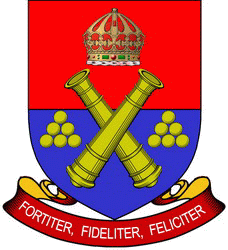
Royal Hutt River
Defence Forces

.gif)

“"Boldly, Faithfully, Successfully"”
.gif)
Royal Hutt River
Army Artillery
![]()

(Click thumbnail for larger view)
Service Awards for The Royal Hutt River Artillery

Click thumbnail for larger view)
4 December
is St. Barbara Day
Field Artillery branches around the world have awards that recognize
outstanding service known as the Order of St. Barbara, who is the patron
saint of artillerists world-wide. The Chief of the Royal Hutt River
Artillery manages The Military Orders of Saint Barbara service awards. Both
field artillerists along with their military and civilian supporters are
eligible for these awards.
Two levels of recognition exist: The Ancient Order of Saint Barbara and The
Honourable Order of Saint Barbara. The most distinguished level is the
Ancient Order of Saint Barbara and those who are selected for this award
have achieved long-term, exceptional service to the field artillery
surpassing even their brethren in the Honourable Order of Saint Barbara. The
receiving of this award links field artillerymen of the past and present in
a brotherhood of professionalism, selfless service and sacrifice.
Receipt of The Ancient Order of Saint Barbara and The Honourable Order of
Saint Barbara service awards is based on nominations from existing
recipients of each award and must be approved by the Chief of The Royal Hutt
River Artillery. Candidates for The Ancient Order of Saint Barbara generally
must be recipients of The Honourable Order of Saint Barbara.
In the present calendars, the feast of Saint Barbara falls on December 4th
(also the RHRDF Day) and is traditionally recognized by a formal Dining-In
or military dinner, often involving presentations of the Military Order of
Saint Barbara service awards.
Read the
2005 St. Barbara Day Proclamation by the Chief of the Royal Hutt
River Artillery.
Read the
2007 St. Barbara Day Proclamation by the Chief of the Royal Hutt
River Artillery.
![]()
According to legend, Saint Barbara was the beautiful daughter of a
wealthy heathen named Dioscorus, who lived near Nicomedia in Asia Minor.
Because of her beauty and fearful that she be demanded in marriage and taken
away from him, he shut her up in a tower to protect her from the outside
world.
Shortly before embarking on a journey, he commissioned a bathhouse to be
built for her, approving the design before he departed. Barbara had heard of
the teachings of Christ, and while her father was gone spent much time in
contemplation. From the windows of her tower she looked out upon the
surrounding countryside and marvelled at the growing things; the trees, the
animals and the people. She decided that all these must be part of a master
plan, and that the idols of wood and stone worshipped by her parents must be
condemned as false. Gradually she came to accept the Christian faith.
As her belief became firm, she directed that the builders redesign the
bathhouse her father had planned, adding another window so that the three
windows might symbolize the Holy Trinity.
Then her father returned, he was enraged at the changes and infuriated when
Barbara acknowledged that she was a Christian. He dragged her before the
prefect of the province, who decreed that she be tortured and put to death
by beheading. Dioscorus himself carried out the death sentence. On his way
home he was struck by lightening and his body consumed.
Saint Barbara lived and died about the year 300 AD. She was venerated as
early as the seventh century. The legend of the lightning bolt which struck
down her persecutor caused her to be regarded as the patron saint in time of
danger from thunderstorms, fires and sudden death.
When gunpowder made its appearance in the Western world, Saint Barbara was
invoked for aid against accidents resulting from explosions--since some of
the earlier artillery pieces often blew up instead of firing their
projectile, Saint Barbara became the patroness of the artillerymen.
![]()
For more information regarding The Royal Hutt River Artillery, the Royal
School of Artillery of the Royal Hutt River Army, or the Military Orders of
St. Barbara, please contact:
The Chief of the Royal Hutt River Artillery.
![]()

RHRDF
HOME
© 2004 - 2018 Ministry of Electronic Communications
Principality
of Hutt River
Unauthorized reproduction prohibited

